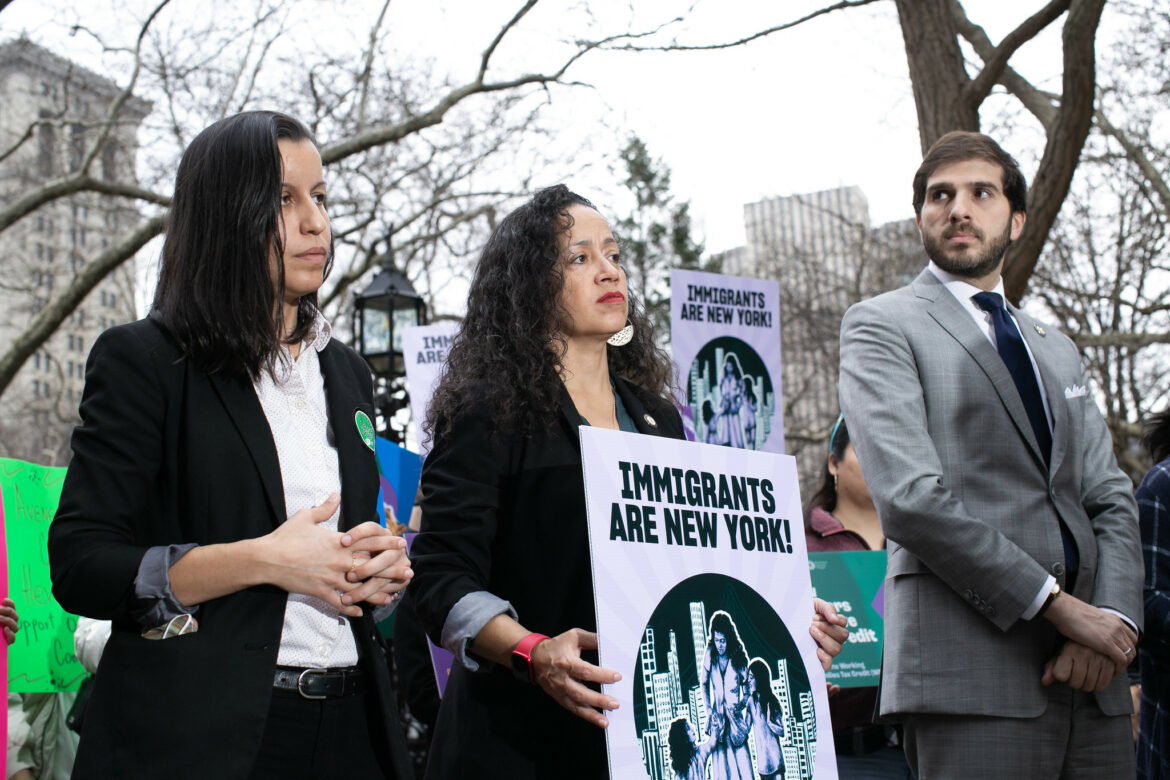Both the Senate and the Assembly have included tax-related reforms in their “one-house” budget proposals that would impact those with Individual Taxpayer Identification Numbers (ITINs), often used by immigrant workers. Advocates say extending credits to this population would help reduce child poverty.

Adi Talwar
Ciria Santiago with her daughter in their Queens apartment on March 8, 2024. Santiago’s family would be among those aided by the proposed Working Families Tax Credit. “I would use that money to save for my daughter’s college,” said Santiago.Lea la versión en español aquí
In 2011, Ciria Santiago began filing taxes with an Individual Taxpayer Identification Number (ITIN)—used by people without Social Security numbers to file federal taxes with the Internal Revenue Service (IRS). But despite having a 10-year-old daughter who was born in the United States, and unlike many other parents who file, she receives no tax credits.
Claudia Vildavila has five children, two of whom—the youngest—were born in the U.S., and she has been filing taxes since she arrived in the country nine years ago. However, she too is unable to claim tax credits on their behalf.
While New York offers some tax credits for which families with mixed immigration status may be eligible, such as the lesser-known Empire State Child Credit, ITIN filers are still unable to access most other credits intended for low-income families, lagging behind several other states that have made more inclusive tax reforms.
Advocates say that locks out many immigrant families with children from the long-term effects and benefits of tax credits in reducing child poverty, at a time when housing and living costs have become increasingly unaffordable for many. They point to an increasingly robust body of research showing the health, educational, and financial benefits that come from such access.
After years of proposed reforms, state lawmakers are about to begin another round of negotiations this session. Both the Senate and the Assembly included tax policy changes in their “one-house” budget proposals unveiled this month. However, the two houses presented differing options.
The Senate included a proposal that would replace the existing Empire State Child Credit with the new, more generous Working Families Tax Credit (WFTC). It would provide a $550 per child credit for single taxpayers earning under $75,000, or $130,000 for married taxpayers filing jointly, targeting the lowest-income families by removing the phase-in provision and allowing them the maximum credit.
The Assembly, in contrast, presented a proposal to include ITIN filers in the Earned Income Tax Credit (EITC), a refundable tax credit for low- to moderate-income working individuals with a valid Social Security number (SSN), which currently disqualifies many mixed-status families filing with an ITIN.
The governor’s executive budget does not include either of these proposals, further complicating the picture at the negotiating table. While state lawmakers will remain in session through June, a state budget deal—often used as a means for passing priority policies—is due April 1.
Both houses have put in a price tag of nearly $500 million on these proposals, according to Assemblyman Andrew Hevesi, who sponsored the Working Families Tax Credit Bill (A4022A) in the Assembly. “The fact that both one houses have funding and some components of the Working Families Tax Credit puts us in an excellent spot to begin negotiations,” Hevesi’s office said in an email.
When asked what the governor’s office thought about including ITIN filers in the state’s tax credits, City Limits did not receive a direct response.
“Governor Hochul’s Executive Budget makes record-setting investments in New York’s future while ensuring the state remains on a stable long-term fiscal trajectory,” said Aja Worthy-Davis, a spokesperson for the governor. “She will work with the Legislature to craft a final budget that achieves these goals.”
The governor’s office noted several provisions to aid working families included in the executive budget: summer food benefits for low-income students; $17 million for departments of social services to connect more New York families to public benefits for which they are eligible; funding to ensure that state-supported youth employment opportunities are maintained; and $50 million to address the immediate needs of children and families in upstate cities.
But advocates, poverty experts, and lawmakers said bigger commitments are needed to achieve greater reductions in child poverty, which the state pledged to reduce by 50 percent over 10 years through the Child Poverty Reduction Act passed in 2021.
Hevesi’s Working Families Tax Credit (WFTC) bill, co-sponsored by State Senator Andrew Gounardes, would consolidate three existing benefits—Empire State Child Credit, Earned Income Tax Credit, and the Dependent Exemption—into one omnibus tax credit.
The bill’s supporters project it would help 2.4 million families.
“Basically, every family with kids in New York State,” said Pete Nabozny, policy director of The Children’s Agenda.
In that figure, families with ITINs would represent only a small fraction.
While the IRS said it has no published data on how many ITIN filers there are in New York, the Institute on Taxation and Economic Policy estimated that approximately 107,610 children live in ITIN-filing households across the state.
“We look at this as being a way to get money into the hands of people who need it most across New York, which is, again, just a huge benefit,” said Liza Schwartzwald, the director of economic justice and family empowerment for the non-profit New York Immigrant Coalition, which has prepared a benefit calculator for the WFTC to estimate how much families could earn.
“The little increase that might exist will benefit me, my daughter, and the whole family. And indeed, my community,” said Santiago, who has rallied in Albany asking more legislators to join in supporting the bill.
Several supporters told City Limits they would like to see both tax proposals included in the Senate and Assembly’s one-house budget resolutions approved.
“Instead of pitting these two priorities against each other,” said Samantha Waxman, deputy director of state policy research at the Center on Budget and Policy Priorities, “New York should raise revenue from wealthy people and profitable corporations to fund them both, and there’s no shortage of good ideas on how to do that.”
“One [house proposal] expands the number of people who are eligible, the other [house proposal] gives more to those who qualify,” said Immigration Research Initiative director David Kallick. “It’s like asking a parent which of their children they care about most.”
But some also said that the proposed WFTC would reach more New Yorkers.
“If the goal is to cut child poverty, the Senate’s proposal would have the more impact,” said Loris Toribio, a senior policy advisor for anti-poverty nonprofit Robin Hood.
Dorothy (Dede) Hill, director of policy at the Schuyler Center for Analysis and Advocacy, seconded that. “The [Senate] proposal provides the largest credit to the lowest income families and is available to families over a broader income range, thus benefiting a larger group of tax filers,” Hill said.
Which would benefit an ITIN filer more, said Nabozny, depends on their marital status, number of children, and most importantly, income. “Nearly all families with four or more children who file using an ITIN would be better off under the Senate plan, while a broader range of families with one child would benefit more from the Assembly plan,” he explained.
The New York State Child Poverty Reduction Advisory Council (CPRAC), established by Gov. Kathy Hochul, has suggested similar reforms for the state in its annual progress reports. The group’s suggestions have included establishing a “relief credit” for rent-burdened New Yorkers with flexible rules around immigration status, and making ITIN filers eligible for child credits.
According to a recent report by the Center on Poverty and Social Policy at Columbia University and Robin Hood, New Yorkers saw the largest annual increase in poverty in a decade from 2021 to 2022, with nearly 2 million New Yorkers living in poverty that year, including one in four children.
While New Yorkers born outside the U.S. also face higher poverty rates, the report says, what is often overlooked is that many of the families of foreign-born parents include children born in the U.S.
“What is really important to include or emphasize or highlight is the many unique barriers that we still need to keep identifying, and then removing, to really allow a lot of these families to be integrated,” said Luisa Godinez-Puig, senior research associate at the Urban Institute. “Many of the children that end up not receiving the Child Tax Credit, for instance, are American children.”

William Alatriste/NYC Council Media Unit
City and state lawmakers at a 2023 rally calling for passage of the Working Families Tax Credit, sponsored in Albany by State Sen. Andrew Gounardes (right).For the two New York immigrant families City Limits spoke with, the destabilizing effects of the pandemic are still unfolding: in the Santiago and Vildavila families, there is still only one primary breadwinner.
Both Santiago and Vildavila have played with the New York Immigration Coalition’s calculator tool to see how their budgets would benefit if the WFTC bill were to pass.
“I would use that money to save for my daughter’s college,” said Santiago.
In addition to ITIN being excluded from some tax credits, many communities are unaware of the benefits for which they are eligible, and so are their tax preparers, Godinez-Puig explained.
“There is a lot of misinformation out there about the availability of these programs for immigrant families,” she said, pointing to several barriers identified in a Boston study that could also be found in New York.
“Passing the legislation to expand the tax parameters and eligibility [is] definitely one thing, and then connecting families to those credits that they’re eligible for, is a whole other thing,” said Aravind Boddupalli, research associate in the Urban-Brookings Tax Policy Center and co-author of the Boston study.
When asked about the prospect of his WFTC bill, State Sen. Gounardes said he’s “very confident that we have enough momentum,” to pass it this year.
”You have Republican sponsors as well. It’s a bipartisan issue. I think people are generally very supportive of it,” he added of the legislation, which currently has 23 sponsors in the Senate.
On the Assembly side, Hevesi said, support for tax credits for working families and the poor is very strong.
“Even more than it was last year,” when the state expanded the Empire State child credit to include children younger than 4.
Both Gounardes and Hevesi said reaching ITIN filers is a priority.
“We don’t want to exclude ITIN filers,” Gounardes said. “That’s a non-negotiable.”
“We have no intention of leaving them out this year,” Hevesi said.
To reach the reporter behind this story, contact Daniel@citylimits.org. To reach the editor, contact Jeanmarie@citylimits.org
Want to republish this story? Find City Limits’ reprint policy here.








